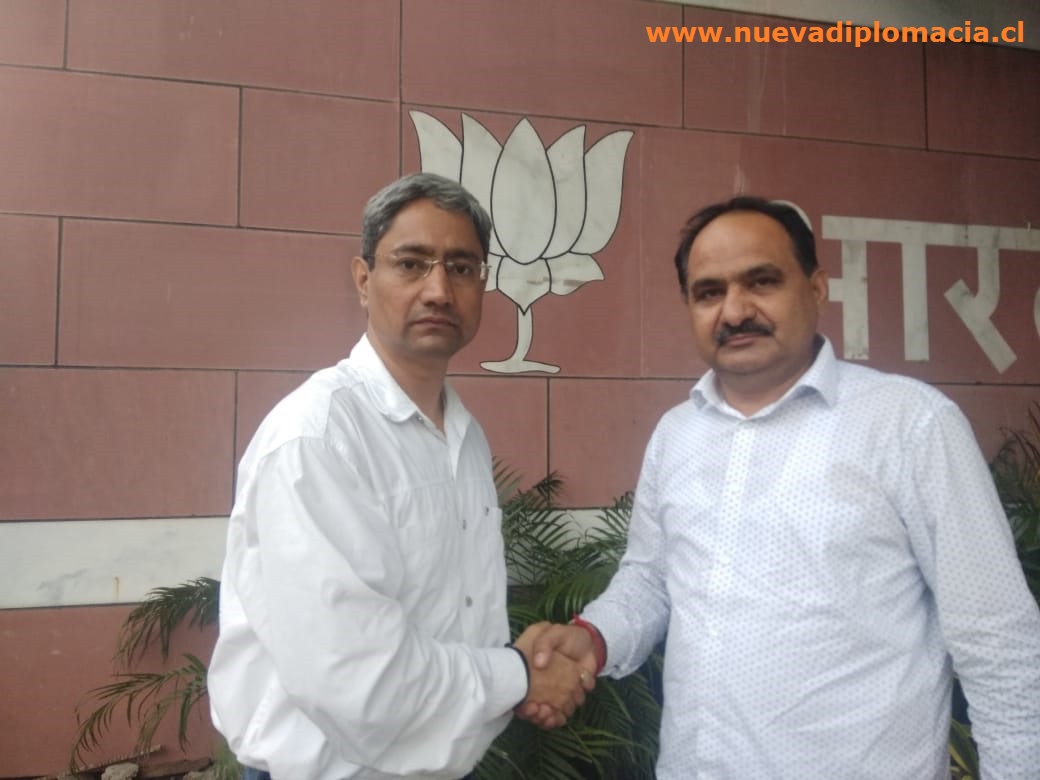
Mr.Manish Uprety F.R.A.S. with Mr. Mukesh Arora
- Manish Uprety: Congratulations on being appointed the BJP’s National Convener for Rural Development and Panchayati Raj. How does it feel to hold such an important portfolio?
Mukesh Arora: Many thanks. I am highly indebted and grateful to the Hon’ble Member of Parliament Sh. Virendra Singh Mast who is also the president of the BJP’s Kisan Morcha and to the Prime Minister of India Sh. Narendra Modi and BJP’s National President Sh. Amit Shah for their faith in me. Considering the fact that India lives in its villages, it is a very big responsibility and I shall try my best to stay true to the belief of my party leadership and its ambition to transform and empower rural India.
- Manish Uprety: While one understands the notion of rural development quite well, how shall our readers relate to Panchayati Raj?
Mukesh Arora: Traditionally South Asia had a system of local bodies governance that catered to the governance needs of the villages. In India, the Panchayati Raj generally refers to the system of local self-government introduced in 1992 by the 73rd amendment to the Indian Constitution. The same was also formalized in 1992 with a goal of implementing more decentralized administration. Panchayati Raj now functions as a system of governance in which gram panchayats or local bodies are the basic units of local administration. The system has three levels: Gram Panchayat (Village level), Mandal Parishad or Block Samiti or Panchayat Samiti (Block level), and Zila Parishad (District level).
- Manish Uprety: At a time when urbanization across the world is becoming the norm, how important is the notion of rural development in the debate that concerns contemporary development?
Mukesh Arora: You have been a diplomat before in the United Nations system and know very well about how important rural economy is for any developing country. Though around 60 percent of the Indian GDP is from the services sector and 18 % from agriculture, over 60% of the Indian population is rural based and linked to the rural economy. In addition small scale industries that amount to 5% of the Indian GDP are also connected to the rural areas.
One has to keep in mind that India’s arable land is 48.83% of its total land area which is the maximum in the world. Hence at a time when our Prime Minister Shri Narendra Modi aspires to make India a USD 5 Trillion economy by 2022, the notion of rural development assumes much importance in the context of inclusive and high growth for our nation.
- Manish Uprety: In a nutshell what have been the priority areas of the government to empower villages and transforming rural India?
Mukesh Arora: I would say that the incumbent government of Prime Minister Narendra Modi focused on diversifying livelihoods, improving infrastructure, reducing poverty, modernizing land records, empowering Gram Panchayats and improving well-being.
- Manish Uprety: Could you elaborate on some of the schemes aimed at rural welfare initiated by the government in the last four years.
Mukesh Arora: The foremost has been the enhanced budget allocation for Gram Panchayats under Finance Commission from INR 65, 160 crore under 13th Finance Commission to INR 2,00,292 crore under 14th Finance Commission and budgetary allocation for Ministry of Rural Development increased from INR 53,155 crore in 2012-13 to INR 1,26,511 crore in 2018-19. In addition, in line with the Hon’ble Prime Minister’s vision of “Housing for all” by 2022, the government shall construct one crore houses by March 2019. Provision of basic amenities like toilet, LPG connection, electricity connection, drinking water etc. through convergence with other programmes is also a priority.
There is also a focus on improving lives by improving roads and road connectivity through Pradhan Mantri Gram Sadak Yojna (PMGSY). Till date road connectivity has been provided to 1,57,345 habitations (88%) against the target of 1,78,184 eligible habitations. The target for completion of PMSGY has been advanced from 2022 to 2019. It is worth noting that the pace of construction of PMGSY roads reached 134 km per day in 2017-18 against an average of 73 km per day during 2011-14, and record road length of 6,313 km was constructed in 2017-18 using green technologies.
One scheme needs special mention which is Deendayal Antyodaya Yojana- National Rural Livelihoods Mission (DAY-NLRM). Though the mission was launched in 2011, it has seen a rapid expansion in the last four years. The footprint of the mission under intensive strategy expanded to 4,465 blocks, spread across 599 districts of 29 states and 5 Union Territories of the country. DAY-NLRM managed to mobilize 4.89 crore women into 41.7 lakh Self Help Groups. During 2014-18, Self Help Groups accessed bank credit of INR 1,41,134 crore.
There is also Shyama Prasad Mukherji Rurban Mission (SPMRM) aimed to realize growth potential of rural clusters. It was launched in February 2016 to create 300 Rurban clusters and addressing gaps in basic, social, economic and digital amenities. It is unique in the sense that it shall help catalyze rural prosperity by identifying growth potential of the rural clusters.
- Manish Uprety: Are there any initiatives that also focus on empowerment of women and youth in the rural scenario?
Mukesh Arora: There is Mahila Kisan Shashaktikaran Pariyojna and Value Chain initiatives under which more than 33 lakh women farmers are being supported. Over 8 lakh women farmers have been mobilized into 86,000 Producer Groups (PGs) which are federated into 126 Producer Companies (PCs). The value chain development initiatives have contributed significantly to increase the farmers’ income from agriculture, horticulture, dairying, fisheries and Non-Timber Forest Produce (NFTP) related activities.
The Start-Up Village Entrepreneurship Programme has been launched to support entrepreneurs in rural areas. Implemented in 17 states since 2016-17, it has supported over 21,070 enterprises resulting in gainful employment for about 50,000 persons.
To empower rural youth through skilling, the government has introduced Deen Dayal Upadhyay Grameen Kaushalya Yojna (DDU-GKY). It is being implemented in 28 states and has 726 active training centres with training in 381 job-roles and 38 sectors. Since 2014-15, a total of 5.74 lakh candidates have been trained and 3.55 lakh candidates have been placed. A web portal and mobile based app KAUSHAL PANJEE was launched for the registration of candidates.
- Manish Uprety: It sounds very impressive. How are things with the famed MNREGA, the Mahatma Gandhi Rural Employment Guarantee Act?
Mukesh Arora: It is but sheer co-incidence that both Mahatma Gandhi and Prime Minister Modi belong to the same state-Gujarat in India. Not to mention the exceptional leadership qualities of both the leaders. While Mahatma Gandhi played a very important role in India’s freedom struggle in the last century, Prime Minister Modi is leading India to its destiny in the twenty first century with his vision for a better, prosperous and peaceful India that plays an important role at the global stage.
The National Rural Employment Guarantee Act 2005 which was later renamed as the “Mahatma Gandhi National Rural Employment Guarantee Act”, MGNREGA, is an Indian labour law and social security measure that aims to guarantee the ‘right to work’. The act was first proposed in the year 1991 and aims to enhance livelihood security in rural areas by providing at least 100 days of wage employment in a financial year to every household whose adult members volunteer to do unskilled manual work. In its World Development Report 2014, the World Bank termed it a “stellar example of rural development”.
The government of India under the leadership of Prime Minister Modi, made the highest budgetary allocation of INR 55,000 crore for MNREGA for the financial year 2018-19. The focus is towards creation of durable assets, Natural Resource Management (NRM), Water Conservation Works and augmentation of livelihoods. I would like to specifically mention that under MNREGA, 1.91 crore assets were created during the last four years (2014-2018) as against 1.38 crore assets created during the last seven years before that which is the period from 2006-2014. The data is sufficient to prove how well MNREGA is faring under the present government. Expenditure on agriculture and allied works has risen from 48% in 2013-14 to 67% in 2017-18.
The results of the affirmative action programmes launched by the Modi government to benefit the neediest are there for all to see. According to the estimates of the recent report by the UN Development Programme (UNDP) and the Oxford Poverty and Human Development Initiative (OPHI) that uses the 2018 global Multidimensional Poverty Index (MPI), India has made giant strides in reducing multidimensional poverty, bringing down its poverty rate from 55 per cent to 28 per cent. The poverty rate has nearly halved and more than 271 million people have come out of the clutches of poverty in India.
- Manish Uprety: India is the world’s largest democracy. What role are the parliamentarians playing in the field of rural development?
Mukesh Arora: The parliamentarians play a very important role to highlight the issues that concern the rural India. It helps in effective policy formulation not only to address the challenges but also to fast track the process of an all inclusive and holistic development initiated by the government.
The Hon’ble Prime Minister launched the Saansad Adarsh Gram Yojna (SAGY) on 11 October 2014 with the objective of creating ideal villages across the country. These Adarsh Grams or ideal villages serve as nucleus of health, cleanliness, greenery and cordiality within the village community as a model to inspire the neighbouring village panchayats. In total 1392 villages were adopted by the Hon’ble Members of Parliament and remarkable progress on a range of parameters including immunization of children, strengthening of Public Distribution System (PDS), enrollment under social security schemes, electrification of villages and delivery of piped drinking water supply has been made.
- Manish Uprety: I remember Prime Minister Modi making announcement some years back that Sikkim has become India’s first Organic state. Are other states following the lead as well and what is government doing to promote organic farming?
Mukesh Arora: The benefits of organic farming are well known. It is not helps build healthy soil profile but is also good for the environment and for the producer and consumer of the organic produce.
It also makes practical sense for the farmers to make a shift to organic farming in India as the country is blessed with a rich livestock. India spent huge amounts on the import of fertilizers. Imports of Fertilisers in India averaged 3336.48 USD Million from 1996 until 2016, reaching an all time high of 12011.24 USD Million in 2008. Because of the steps undertaken by the Modi government, imports of Fertilisers in India decreased to 540.06 USD Million in 2016 from 4755.63 USD Million in 2015.
To popularize the use of organic manure in the farming sector, the government has also introduced subsidy for the willing farmers. It not only saves the nation’s foreign reserves by cutting import and use of fertilizers but also empowers the farmers at the grassroots.
- Manish Uprety: How interesting. One can say that the above are wonderful examples of Schumacher’s Small is beautiful. What role does your office play in all of the above?
Mukesh Arora: As BJP’s National Convener for Rural Development and Panchayati Raj, my role is to disseminate information about the policies and programmes initiated by the government for rural welfare to the farmers and the village panchayats. The work also encompasses developing grassroots networks and providing feedback to my party and to the policy makers which helps them develop and better policies for the welfare of villages and farmers. I firmly believe that developed and prosperous villages shall be an important component of a prosperous India.
- Manish Uprety: It was a pleasure speaking with you on behalf of Nueva Diplomacia. My best wishes for the wonderful work you are doing for the development of rural India and empowerment of farmers.
Mukesh Arora: Thank you. It was a pleasure speaking to you too and I extend my warm greetings to the readers of Nueva Diplomacia.
*DISCLAIMER* Nueva Diplomacia does not take any responsibility for the views and opinions expressed in the interview which belong solely to the interviewee.











